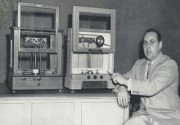Improved Balance Design Speeds Laboratory Work

To appreciate how time—and tempers can be saved in daily use of laboratory balances, let’s go through a typical weighing operation, using a balance of modern design. First of all, there’s no time wasted in adjusting the zero point of the balance. Any slight variation from zero is quickly corrected. You just shift the index plate by Autodex, a control operated from outside the case. Raising the front door, you’ll notice there’s plenty of hand room—no corner posts to get in your way, and no vertical chain column to restrict your access to the right pan. Loading of pans is fast and easy. Now you have your sample and weights on the pans and you’ve closed the door.
Loading of pans is fast and easy. Now you have your sample and weights on the pans and you’ve closed the door. At this point, you’ll find the adjustable Alnico damper helpful. It’s vernier graduated for rapid duplication of settings—a feature especially welcomed by those who use the balance many times throughout the day. To release the pans, simply turn the knob. The individual pan arrest, with positive stop and even release, is mounted under the base plate and adjustable from above. This permits centering of bows after weights are placed on the pans and reduces knife edge wear.
Beam arrestment is easy and positive. The beam arrest arms and beam are pivoted about a common axis. This insures positive alignment and contact between knife edges and bearings with no dulling of agate edges. In final balancing, you don’t take your reading from a chain column as in previous balance designs. You refer, instead, to the easy-to-read Chainomatic dial, with its large numerals at convenient, constant eye-level position. There are other sight-saving features, too, in modern balance design. The case is tapered to focus light on the working area. White matte inside finish adds brightness without glare. And white opal back glass elim-inates background distraction. It’s a revelation, users tell us, how much faster, more effectively, they can work with these improved balances. Christian Becker makes a full range of 23 models, meeting virtually all laboratory needs. If, on the other hand, you have an unusual problem, where a non-standard balance seems to be indicated, Christian Becker will adapt one of the present models or develop an entirely new design to answer your requirements.
Christian Becker also offers complete repair and reconditioning services. Just send in your old or damaged Christian Becker balance for a firm quotation—without charge or obligation—on the cost of restoring it to topnotch working condition.
